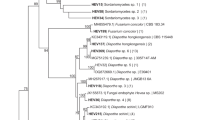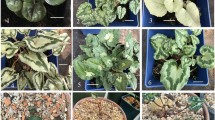Abstract
The diversity among 45 cyanobacterial isolates from 11 different Gunnera species originating from different geographical areas was examined. By means of polymerase chain reaction (PCR) fingerprinting with short tandemly repeated repetitive (STRR) sequences as primers, ten groups of symbiotic cyanobacteria and five unique isolates not belonging to a particular group were identified. Most groups were restricted to one geographical area, indicating a limited distribution of related cyanobacterial strains. An extensive cyanobacterial diversity was found both within and between the 11 different Gunnera species. Within a particular plant and even within the same stem gland, more than one cyanobacterial strain at a time could be present. These results indicate a low specificity in Gunnera-Nostoc symbiosis.
Similar content being viewed by others
Author information
Authors and Affiliations
Additional information
Electronic Publication
Rights and permissions
About this article
Cite this article
Nilsson, M., Bergman, B. & Rasmussen, U. Cyanobacterial diversity in geographically related and distant host plants of the genus Gunnera . Arch Microbiol 173, 97–102 (2000). https://doi.org/10.1007/s002039900113
Received:
Accepted:
Published:
Issue Date:
DOI: https://doi.org/10.1007/s002039900113




